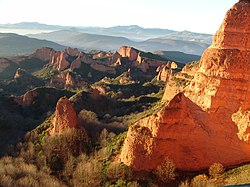Las Médulas
| Las Médulas | |
|---|---|
|
UNESCO world heritage |
|

|
|
| Panorama of Las Médulas |
|
| National territory: |
|
| Type: | Culture |
| Criteria : | i, ii, iii, iv |
| Reference No .: | 803 |
| UNESCO region : | Europe and North America |
| History of enrollment | |
| Enrollment: | 1997 (session 21) |
The Las Médulas are located near the Spanish city of Ponferrada , province of León , in the autonomous community of Castile and León . It was the most important gold mine in the Roman Empire . The cultural landscape of Las Médulas has been listed as a UNESCO World Heritage Site since 1997 .
The extraordinary landscape is a result of the ruina montium , a Roman mining technique . Pliny the Elder describes them in his Naturalis historia as perforating the mountains and later flooding them with large amounts of water. This is said to have literally eroded the hills. In order to bring the required amounts of water from the Sierra de la Cabrera , a canal system over 100 kilometers long was built. Parts of this system are still preserved today.
Under the reign of Augustus the area by the Romans after lengthy campaigns was ( Cantabrian Wars , 29 - .. 19 BC ) finally occupied. According to Roman sources, the reason for the Roman intervention is the constant raids by the Cantabrians on neighboring Roman regions and their attempt to expand their sphere of control. In addition, the region of the Cantabrians was of economic interest to the Romans due to its ore wealth, so they began to exploit the gold mines, Las Médulas, shortly after the conquest. Publius Carisius conquered Las Médulas in 25 BC. In the battle for Mons Medullius.
Description by Pliny the Elder
“The third way (to mine gold) is beyond the work of giants. The mountains are hollowed out with corridors and tunnels in the light of lamps ... For months the miners see no sun ... Suddenly the crevices collapse and the workers spill, so that it seems less daring to fetch pearls and purple snails from the depths of the sea. How dangerous we have made the earth! "
Pliny also stated that 20,000 Roman pounds of gold were mined each year . 60,000 free workers were involved in the exploitation, which produced 1635 tons in 250 years.
Web links
- Internet presence of the Las Médulas Foundation, with maps, virtual tour and information
- Official entry at UNESCO
- Photo gallery and explanation of funding
- Las Medulas and its gold mines in the Treasures of the World series
Individual evidence
- ↑ Pliny, Naturalis historia 33, 66 and 70-76 .
- ↑ Francisco Diego Santos: The integration of north and north-west Spain as a Roman province in the imperial policy of Augustus. In Wolfgang Haase , Hildegard Temporini (Hrsg.): Rise and decline of the Roman world . Vol. 3. De Gruyter, Berlin 1975, ISBN 3-11-005838-3 , p. 528 ( limited online version in the Google book search)
- ↑ Meret Strothmann : Augustus - father of the res publica: on the function of the three terms restitutio-saeculum-pater patriae in the Augustan Principate. Stuttgart 2000, p. 145 ( restricted online version in the Google book search)
- ↑ Pliny, naturalis historia 33, 70.
Coordinates: 42 ° 27 ′ 38.4 " N , 6 ° 45 ′ 33.6" W.



